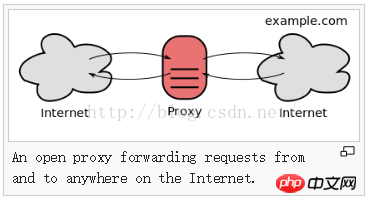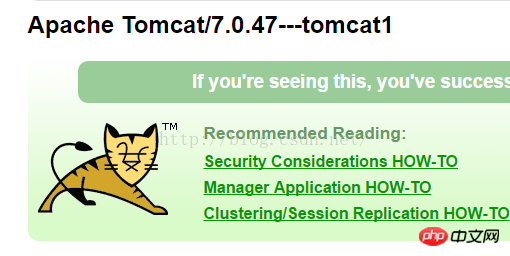Home >Backend Development >PHP Tutorial >PHP uses Nginx to implement reverse proxy
PHP uses Nginx to implement reverse proxy
- 不言Original
- 2018-04-09 17:33:475294browse
This article mainly introduces in detail the method of using Nginx to implement reverse proxy in PHP. It has certain reference value. Friends in need can refer to it
1. Proxy server
1. What is a proxy server?
#Proxy server, when the client sends a request, it will not directly send it to the destination host, but It is first sent to the proxy server. After the proxy service accepts the client's request, it sends it to the host, receives the data returned by the destination host, stores it in the hard disk of the proxy server, and then sends it to the client.

2. Why use a proxy server
1) Improve access speed
Since the data returned by the target host will be stored in the hard disk of the proxy server, the next time the customer accesses the same site data, it will be read directly from the hard disk of the proxy server, which plays a cache role, especially for Popular sites can significantly increase request speeds.
2) Firewall function
Since all client requests must access remote sites through the proxy server, restrictions can be set on the proxy server to filter certain unsafe information.
3) Access inaccessible target sites through proxy servers
There are many developed proxy servers on the Internet. When access is restricted, the client can access the target through unrestricted proxy servers. Site, in layman's terms, the circumvention browser we use uses a proxy server. Although it cannot go abroad, it can also directly access the external network.
2. Reverse proxy VS forward proxy
1. What is a forward proxy? What is a reverse proxy?
Forward proxy is set up between the client and the target host. It is only used to proxy the connection request from the internal network to the Internet. The client must specify the proxy server and send the request directly to the Web server. HTTP requests are sent to the proxy server.

The reverse proxy server is set up on the server side. It relieves the workload of the server by buffering frequently requested pages and forwards client requests to the internal network. The target server; and returns the results obtained from the server to the client requesting a connection on the Internet. At this time, the proxy server and the target host appear as a server to the outside world.

#2. What are the main applications of reverse proxy?
Many large web sites now use reverse proxies. In addition to preventing vicious attacks from the external network on intranet servers, caching to reduce server pressure and access security control, it can also perform load balancing and distribute user requests to multiple servers.
3. Directional proxy server Nginx
Nginx, as a popular reverse proxy server in recent years, is installed on the destination host and is mainly used to forward client requests. There are multiple HTTP servers in the background to provide services. The function of nginx is to forward the request to the subsequent server and decide which target host to handle the current request. The following demonstrates how to configure Nginx to function.
1. Simulate n http servers as target hosts
For testing, simply use 2 tomcat instances to simulate two http servers, and change the tomcat ports to 8081 and 8082 respectively
2. Configure IP domain name
192.168.72.49 8081.max.com
192.168.72.49 8082.max.com
3. Configure nginx.conf
upstream tomcatserver1 {
server 192.168.72.49:8081;
}
upstream tomcatserver2 {
server 192.168.72.49:8082;
}
server {
listen 80;
server_name 8081.max.com;
#charset koi8-r;
#access_log logs/host.access.log main;
location / {
proxy_pass http://tomcatserver1;
index index.html index.htm;
}
}
server {
listen 80;
server_name 8082.max.com;
#charset koi8-r;
#access_log logs/host.access.log main;
location / {
proxy_pass http://tomcatserver2;
index index.html index.htm;
}
}
Process:
1) Access 8081.max.com with the browser and find the 192.168.72.49 server through local host file domain name resolution (Installing nginx)
2) The nginx reverse proxy accepts the client request, finds the server node with server_name 8081.max.com, and forwards the request to upstream tomcatserver1 according to the http path corresponding to proxy_pass, which is the port Tomcat server number 8081.
4. Effect display
Request 8081.max.com, tomcat1 receives and returns to the home page

Request 8082.max.com, tomcat2 Receive and return to the homepage

## IV. Summary
Through analysis, it is not difficult to conclude that, taking Baidu as an example, if the customer If the IP of the computer and the IP of Baidu server (target host) are in the same network segment, it will be like sending a request within the LAN, and the speed is extremely fast.But if this demand cannot be met and you still want to achieve a better request response, Baidu server can provide a public network IP in the same network segment as the target server, which is the IP of the reverse proxy service, through The proxy server forwards the client request and determines which of the N servers behind the scenes will handle the request. Since the reverse proxy server is on the same network segment as the target host, the access speed will be very fast.
When Nginx is used as a reverse proxy server, it is one of many reverse proxy servers. Through simple configuration, the client request can be forwarded to the designated server for processing by specifying the server IP or domain name address. ask.
The above is the detailed content of PHP uses Nginx to implement reverse proxy. For more information, please follow other related articles on the PHP Chinese website!

